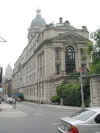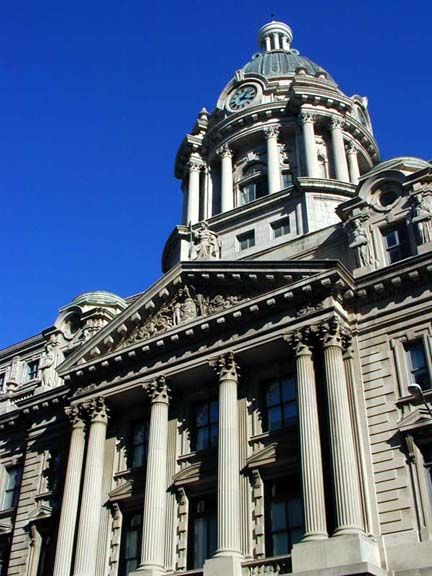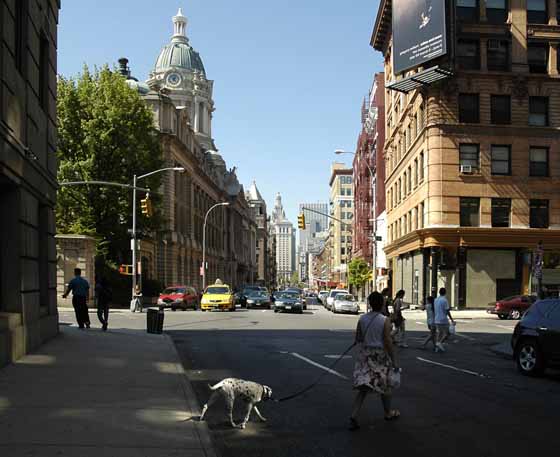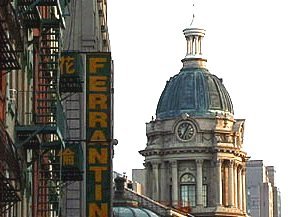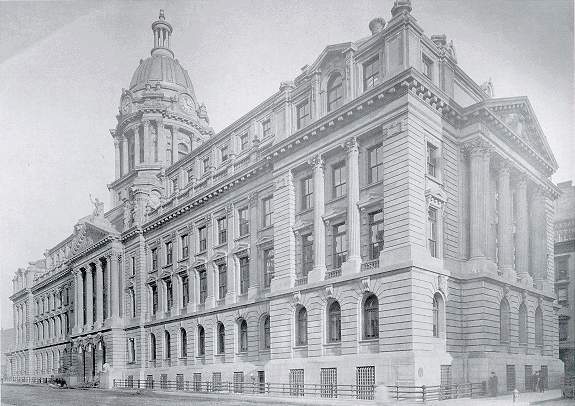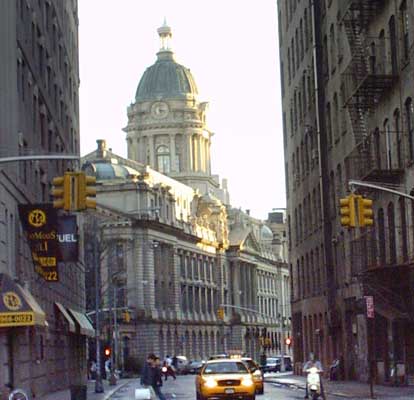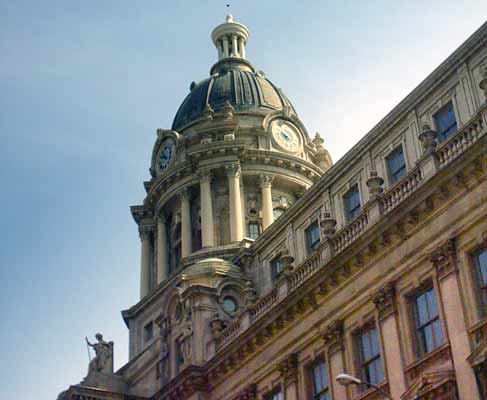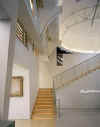|
PATROL IN THE OLD
4TH PRECINCT
Patrolman John
Timothy, 4th Precinct had a fighter's mug. He was one tough
looking guy. He had a couple of years on the job at the time, but he
still felt closer to the newer guys than the old-timers. We were working
a late tour together when we got a call of a "fight with a knife" on
Greenwich Street inside what was then called "The Washington Street
Market". It was 1964 and Manhattan's lower West Side has undergone many
changes since then.
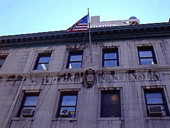 The
Washington Market was packed with tractor-trailer trucks arriving from
Florida, California and other States with everything from oranges to
potatoes. After the tractor-trailers would be unloaded into the various
dealerships, the pallets of produce would be stacked to the first floor
ceilings. Then, the local delivery trucks would line up to purchase
quantities of foodstuffs for delivery to their customers. The narrow
streets of Washington Street, Greenwich Street, from West Houston Street
south to Fulton Street were choked with trucks. Once a sector car
responded to a job in the Market, the cops had all they could do to get
their car back out again. The
Washington Market was packed with tractor-trailer trucks arriving from
Florida, California and other States with everything from oranges to
potatoes. After the tractor-trailers would be unloaded into the various
dealerships, the pallets of produce would be stacked to the first floor
ceilings. Then, the local delivery trucks would line up to purchase
quantities of foodstuffs for delivery to their customers. The narrow
streets of Washington Street, Greenwich Street, from West Houston Street
south to Fulton Street were choked with trucks. Once a sector car
responded to a job in the Market, the cops had all they could do to get
their car back out again.
John and I were forced to park the radio car on Franklin Street just off
Hudson and run to the scene of the knifefight. We could hear the roar of
the crowd of onlookers who had formed a circle around the two men locked
in a death struggle. We ploughed into the crowd and shouldered our way
into the interior of the circle. John charged the bigger of the two
fighters and hit him with a shoulder block knocking him back. The
shocked fighter dropped the knife, which looked like a linoleum knife
with a hooked blade. The other guy immediately indicated his submission
by dropping his knife and raising his empty hands as I shoved him back
against the ring of shouting men. Some of the crowd of workers were
disappointed that we had ended the fight, but many others were relieved
that we had prevented what could have been a homicide.
The Washington Street Market was a busy area during the late tour.
The "ABC laws" governed the hours when bars and grills could be open for
business. The hours were different for the ginmills in the Market
area. They could remain open beyond the 4AM closing times of other
sections of the City. This was done to accommodate the hundreds of
truckers and employees of the produce markets who worked throughout the
night while the rest of the City slept. The all-night Market enabled the
thousands of restaurants and produce stores throughout the City to have
their foodstuffs delivered each morning. Years later, the Washington
Street Market was relocated to the Bronx in the Hunt's Point section.
Back in the l960s, the old Washington Street Market attracted hundreds
of unemployed workers looking for a night's work. It also was a
good place for a guy on the lam to keep a low profile while working odd
jobs. Many times, a routine arrest for disorderly conduct would became a
homicide or robbery arrest when the fingerprints came back showing the
prisoner was wanted. Stopping to question a so-called "derelict"
could be a dangerous move for a cop on patrol in this area.
The cops that worked in the old 4th Precinct went unrecognized for their
efforts. It was considered a "slow" precinct and most new cops didn't
want to be assigned to a quiet precinct. Yet, there were many
experienced cops working in that command. The NYPD would often
punish an experienced detective or former plainclothes officer by
demotion and transfer back to patrol. Such officers were bitter to a
certain extent, but patrol in Manhattan's 4th Precinct wasn't the worst
way to finish up a career. It was still in the "Big Apple" and the
excitement of working in Manhattan still had its compensations. It would
be many years later before people would give names such as "Soho" and
"Tribeca" to the old 4th Precinct. Today, "Soho" is filled with art
galleries and restaurants. In l963, the streets were deserted after the
fabric jobbers and wholesalers closed for business. It was also a
section of Manhattan that had witnessed some horrific incidents in the
past.
The area north of Canal Street was filled with old loft buildings. The
cast iron façade buildings of the 19th century were plentiful here. Some
were used by textile jobbers who sold all types of fabric for the
manufacture of clothing or household goods. When we would handle police
incidents in those buildings, it wasn't unusual to see the lofts filled
to the ceilings with gigantic bolts of fabric. Most of those
buildings with the cast iron facades were only six stories.
On March 25, l9ll, there was a deadly fire in the Triangle Shirtwaist
Factory a few blocks north of West Houston Street in the 6th Precinct.
The factory building had 12 stories. The exit doors were locked and
there were inadequate fire escapes for the hundreds of young women
toiling at their work. A fire broke out on the 8th floor and trapped
many of the women inside. Many jumped from the upper floors to
their deaths. A total of 146 women lost their lives in that
tragedy. They called those factories "sweatshops". The women
who died in that fire were mostly young Jewish immigrant women. There
were many such shops still in operation in the area, and it seemed the
lessons of the past had gone unheeded.
On a hot summer day, I responded to a report of a "cardiac" in a sweatshop
located on Broadway near Spring Street. My radio partner was
Patrolman Ralph Vega who was fluent in Spanish. We climbed the stairway
to the second floor where a burly security guard unlocked the gate and
admitted us to the work area. A man needing a shave and dressed in a
white shirt seemed to be the supervisor. He urged the women to
continue their work despite the presence of the police. The air was
filled with the noise of scores of sewing machines. The heat was
oppressive as the women toiled at their workstations. Their black
shoulder length hair was matted with sweat and their dresses clung to
their bodies. Most of them were young Puerto Rican women. There were
piles of fabric everywhere. The electric cords for the sewing machines
and the overhead lighting were strung haphazardly. A small cluster
of the workers stood near an older woman lying on the floor. After
checking the condition of the woman, we could see that she was a victim
of heat exhaustion. We applied cool compresses to her forehead and
she was recovering quickly as we waited for the ambulance. As we waited
in the smothering heat, some of the women at the sewing machines were
shouting remarks in Spanish. Officer Vega was smiling from ear to ear.
Then he burst into laughter and spoke to some of them in Spanish.
They blushed visibly and their eyes dropped in embarrassment.
Vega later told me that they were talking about me and how they liked my
butt. We helped carry the woman out to the ambulance and the security
guard slammed the gate behind us as we started down the stairway. The
sweatshop supervisor shouted commands in Spanish and the whirring of the
sewing machines increased in intensity. The hot interior of the radio
car didn't seem so uncomfortable anymore. I thought of the workers
inside the sweatshop and the miserable conditions that they worked
under. The locked gate and the number of women in that factory was
formula for disaster.
Patrolman Tom Dolan was a veteran of the old 4th Precinct. Tom had been
assigned for a number of years to plainclothes duty. When I was a
rookie, I filled in for his regular partner who had taken the tour off.
Tom looked me over and just shrugged his shoulders as we pulled away
from the curb to patrol the north end of the precinct. Tom was a big guy
and I didn't think my 150 pounds impressed him. We didn't talk
much during those first few hours on patrol.
When the radio dispatcher called for us to respond to a burglary run, I
learned a lesson in police work. We were patrolling on West Houston
Street and he told me to turn onto Mercer Street and shut off the
headlights. I pulled the radio car onto the sidewalk and kept as close
to the buildings as I could. We sat in the darkened car and
watched in the direction of Prince Street. The streetlights reflected
off the old paving blocks worn smooth by decades of traffic. The facades
of the old buildings stood in silence with their tiers of rusted fire
escapes. Seconds later, a furtive figure hustled
across Mercer Street on Prince headed east. He was carrying a load
of clothing over his shoulder. Tom's face lit up with a knowing smile as
I turned on the headlights and pulled the car alongside as he walked.
Tom greeted him cheerfully and inquired about the "swag". The suspect
was obviously a derelict and the "swag" was expensive clothing and
various personal belongings. We tossed him for weapons and after a
few evasive answers, Tom handcuffed the suspect to a wrought iron
lamppost. 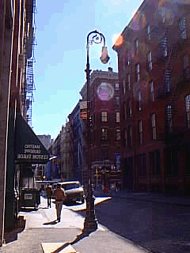 Today,
there are still some of those old iron lampposts around. Today,
there are still some of those old iron lampposts around.
They have a
distinctive look. We threw the clothing into the sector car and
proceeded to the address of the radio run. The caller was an
artist in residence or "AIR". In those days, artists had discovered the
buildings below West Houston Street were ideal for their studios.
Eventually, over the years, many other artists would follow these
pioneers and the area would become known as "Soho" (south of Houston
Street). When we talked to him, he was very annoyed with the lack
of police protection. He had returned home to find an unidentified
male ransacking his studio. The suspect fled to the roof with his
belongings. His description matched that of the suspect we had
cuffed to the lamppost. When we returned the suspect to the scene,
the artist was overjoyed to find we had arrested the burglar and
recovered his property. I must admit that Tom's methods were unorthodox,
but very effective.
As a rookie cop, I walked foot posts in the 4th Precinct and "flew" to
division and borough details throughout the Borough of Manhattan. There
were only four sector cars that worked the precinct in those early
years, so most of the platoon walked foot or flew to outside commands.
There was no overtime paid back in 1963, and portal-to-portal pay was in
the future. Often, when I would prepare my monthly activity
report, I would find that I had worked only a few tours in the 4th
Precinct. The rest of the time, I had worked details outside my Command.
"Flying" was an expensive proposition. However, after a few years of it,
a street cop got pretty good at improvisation. Truck drivers and
most motorists would be only too glad to give a ride uptown or
cross-town to a uniformed cop. When assigned to a demonstration up in
Times Square or a parade detail on Fifth Avenue, it was a breeze to
thumb a ride downtown on Seventh Avenue.
The veteran cops of the old 4th Precinct knew that a rookie cop had to
learn the job quickly. The desk officers and patrol sergeants took
matters into their own hands. They would instruct the sector cars to
have the new cops issue their first summons. They knew that the
actual issuance of a ticket to an angry motorist would be a new
experience for rookies. Next, they would get the new cop his first
collar. In my case, I was walking foot post on Greenwich Street
near Park Place when a sector car picked me up and brought me to the
scene of a burglary nearby. The owner of a food distributing company had
caught a young burglar in the act as he was stealing produce from the
building. I interviewed the owner and the suspect. The sector car
transported me and the prisoner into the precinct with my first felony
arrest. After I processed the collar in the precinct, Lieutenant
Fulton told me to cuff up my prisoner and walk him the few blocks to the
courthouse at 100 Centre Street. Today, such a practice would be
frowned upon. He assigned an experienced cop to help me with the
arraignment procedures. Processing that first felony collar was
good on the job training. It showed a new cop how to handle an arrest
and eventually gain experience testifying in court.
The arrest procedure at that time involved taking the prisoner to the
detective squad office for process. While the arresting officer
prepared arrest cards, the detective on duty would debrief the prisoner
and prepare a DD 19 Pedigree and M.O. form. The DD19 was a full
description of the prisoner and manner in which the crime had been
committed. That was before the landmark Miranda Decision, and the
detective would interrogate the prisoner. Many times, the prisoner
would make incriminating statements and the detective could clear other
cases as a result of the interrogation. It was amazing to watch a
veteran detective conduct a skilled interrogation of a prisoner.
The "Mutt and Jeff" routine was classic. The good guy-bad guy
method often got quick admissions by prisoners. Miranda ended all those
time-honored methods. There was one thing about the DD 19 that I found
personally offensive. There was a category entitled: "unusual
peculiarities". Physical imperfections such as a scars, tattoos,
physical deformities, and left-handedness were listed. As a
southpaw, I resented that. The detectives also fingerprinted and
photographed the prisoner. Arrests made on the evening and late tours
required that part of the arrest procedure was to transport felony
arrests and serious misdemeanors as listed in section 552 of the Code of
Criminal Procedure to the Line-up Room at 240 Centre Street.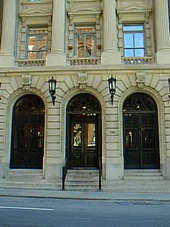
At 7
AM, lines of patrolwagons from various precincts would pull into Centre
Market Place behind headquarters and strings of prisoners would be led
from the wagons into the basement entrance. Prints would be
dropped off at the old Bureau of Criminal Investigations (BCI) at 400
Broome Street. When the "yellow sheets" would come back with the
prisoner's criminal record, they would take a "stand-up" photo. Finally,
the prisoner would stand in a line-up on a stage while a detective would
read the details of the arrest aloud. The lineups were monitored
by all the detective squads via closed-circuit television. This
was before the Supreme Court had rendered the famous "Wade Decision"
that set guidelines for line-ups. The old Line-up Room is an
anachronism of the past, but it was an experience to see those
detectives work a room full of suspects.
Patrolman Charlie Schmidt, 4th Precinct, worked the Warren Street post in
the Market. Warren Street between West Broadway and Greenwich
Street was the site of a number of unemployment agencies. The post was
only one block long, but it was more than most cops could handle.
These agencies were filled with unemployed workers seeking day jobs.
Most of the listings were for menial type work such as dishwashers or
porters. Men were hired for part-time or on a daily basis. Here too,
criminals wanted on warrants, fugitives from justice, or just plain
drifters, could support themselves with work and not be asked too many
questions.
On any day, there would be disputes between disgruntled men in the large
crowded rooms of the agencies. The interior of those rooms was not
air-conditioned and the stench of the sweating bodies of hundreds of
aggravated jobseekers filled the fetid air and smothered the lungs. When
a job would come over the radio of a fight on Warren Street, you could
bet it would be inside one of the agencies. On a hot summer day, your
dark blue uniform shirt would be saturated with sweat from sitting in
those sweltering radio cars. I would always be glad when I would find
"Mr. Charlie" on the scene of those fights.
Charlie was the guy who could handle this post as no other cop could.
Charlie was a man with eyes that penetrated into your skull. He was an
infantryman in Europe during World War II. He had seen a lot of action.
The Warren Street post was a piece of cake to him. He was a cop that the
downtrodden men who frequented Warren Street could trust. They knew he
could keep a confidence. Many times, Charlie would take one of the
denizens of the street into his "confessional box". The arrests that he
made based on information provided by the least of them would amaze the
cops of today. He had better sources of information than the detective
squad. When he went sick or took vacation, I would sometimes be assigned
to the Warren Street Post. Believe me when I tell you, it was a long
tour of duty for me.
Patrolman Bernard Miller was the "old hand" of the 4th Precinct. He was a
mature and seasoned cop. There was a reason why he was so steady
in the street. He had spent his young years fighting World War II.
He saw years of combat in Europe assigned to an Armored Reconnaissance
Unit of the 102nd Cavalry. His unit and others like it spearheaded the
advance of the American Army. He spent most of his time manning a .37 MM
cannon and a .50 Caliber machine gun in some of the toughest campaigns
of the war. When he was discharged, he and 100.000 other veterans took
the test for Patrolman, PD. He was appointed in 1946, and spent
his entire career in the old 4th Precinct. Back in l965, Bernie and I
were assigned the same detail for the visit of Pope Paul VI.
We were assembled in ranks with the detail of hundreds of cops.
The detail sergeants took roll call and we were assigned. Our sergeant
was an old-timer who peered over his glasses and sized up his detail.
"Who got a whistle?" he drawled. Not a cop stirred although
the regulation white whistle dangling from every gunbelt. After a
pregnant pause, I responded that I had one. The entire detail broke into
laughter. I had been had. "OK, kid, your post is the roof of this
here building" said the sergeant. I spent the tour on the windy roof of
an office building. I didn't get to see the Pope, but I learned how to
keep my mouth shut in formation.
©Copyright
l999 Edward D. Reuss
|
